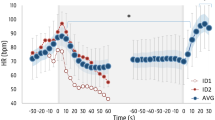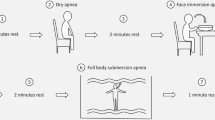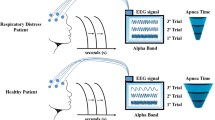Abstract
Purpose
The aim of the study was to investigate the effects of voluntary breath-holding on brain activity and physiological functions. We hypothesised that prolonged apnoea would trigger cerebral hypoxia, resulting in a decrease of brain performance; and the apnoea’s effects would be more pronounced in breath-hold divers.
Methods
Trained breath-hold divers and non-divers performed maximal dry breath-holdings. Lung volume, alveolar partial pressures of O2 and CO2, attention and anxiety levels were estimated. Heart rate, blood pressure, arterial blood oxygenation, brain tissue oxygenation, EEG, and DC potential were monitored continuously during breath-holding.
Results
There were a few significant changes in electrical brain activity caused by prolonged apnoea. Brain tissue oxygenation index and DC potential were relatively stable up to the end of the apnoea in breath-hold divers and non-divers. We also did not observe any decrease of attention level or speed of processing immediately after breath-holding. Interestingly, trained breath-hold divers had some peculiarities in EEG activity at resting state (before any breath-holding): non-spindled, sharpened alpha rhythm; slowed-down alpha with the frequency nearer to the theta band; and untypical spatial pattern of alpha activity.
Conclusion
Our findings contradicted the primary hypothesis. Apnoea up to 5 min does not lead to notable cerebral hypoxia or a decrease of brain performance in either breath-hold divers or non-divers. It seems to be the result of the compensatory mechanisms similar to the diving response aimed at centralising blood circulation and reducing peripheral O2 uptake. Adaptive changes during apnoea are much more prominent in trained breath-hold divers.






Similar content being viewed by others
Abbreviations
- C-group:
-
Control group
- D-group:
-
Breath-hold divers’ group
- DC potential:
-
Direct current potential
- ECG:
-
Electrocardiogram
- EEG:
-
Electroencephalogram
- HR:
-
Heart rate
- MAP:
-
Mean arterial pressure
- BH:
-
Breath-holding
- PA CO2 :
-
CO2 partial pressure in alveolar air
- PA O2 :
-
O2 partial pressure in alveolar air
- RB:
-
Rhythmical breathing before breath-holding
- SpO2 :
-
Arterial blood oxygenation index
- TOI:
-
Brain tissue oxygenation index
- \(\dot{V}\)CO2 :
-
Carbon dioxide release rate
- \(\dot{V}\)O2 :
-
Pulmonary oxygen consumption rate
- Δ[tHb]:
-
Change of total haemoglobin in brain tissue
References
Cross TJ, Kavanagh JJ, Breskovic T, Zubin Maslov P, Lojpur M, Johnson BD, Dujic Z (2013) The effects of involuntary respiratory contractions on cerebral blood flow during maximal apnoea in trained divers. PLoS One 8:e66950
Fagoni N, Sivieri A, Antonutto G, Moia C, Taboni A, Bringard A, Ferretti G (2015) Cardiovascular responses to dry resting apnoeas in elite divers while breathing pure oxygen. Respir Physiol Neurobiol 219:1–8
Ferretti G (2001) Extreme human breath-hold diving. Eur J Appl Physiol 84:254–271
Ferretti G, Costa M (2003) Diversity in and adaptation to breath-hold diving in humans. Comp Biochem Physiol A Mol Integr Physiol 136:205–213
Ferretti G, Costa M, Moroni R, Ranieri P, Butti F, Sponsiello N (2012) Lung volumes of extreme breath-hold divers. Sport Sci Health 7:55–59
Fitz-Clarke JR (2006) Adverse events in competitive breath-hold diving. Undersea Hyperb Med 33:55–62
Gooden BA (1994) Mechanism of the human diving response. Integr Physiol Behav Sci 29:6–16
Grenèche J, Krieger J, Erhardt C, Bonnefond A, Eschenlauer A, Muzet A, Tassi P (2008) EEG spectral power and sleepiness during 24 h of sustained wakefulness in patients with obstructive sleep apnea syndrome. Clin Neurophysiol 119:418–428
Guaraldi P, Serra M, Barletta G, Pierangeli G, Terlizzi R, Calandra-Buonaura G, Cialoni D, Cortelli P (2009) Cardiovascular changes during maximal breath-holding in elite divers. Clin Auton Res 19:363–366
Hall EL, Driver ID, Croal PL, Francis ST, Gowland PA, Morris PG, Brookes MJ (2011) The effect of hypercapnia on resting and stimulus induced MEG signals. Neuroimage 58:1034–1043
Halpern P, Neufeld MY, Sade K, Silbiger A, Szold O, Bornstein NM, Sorkine P (2003) Middle cerebral artery flow velocity decreases and electroencephalogram (EEG) changes occur as acute hypercapnia reverses. Intensive Care Med 29:1650–1655
Joulia F, Lemaitre F, Fontanari P, Mille ML, Barthelemy P (2009) Circulatory effects of apnoea in elite breath-hold divers. Acta Physiol Oxf 197:75–82
Kida M, Imai A (1993) Cognitive performance and event-related brain potentials under simulated high altitudes. J Appl Physiol 74:1735–1741
Kornienko VN, Pronin IN (2009) Diagnostic neuroradiology. Springer, Berlin
Kusakov I (2012) Deconcentration of attention: addressing the complexity of software engineering. http://deconcentration-of-attention.com. Accessed 27 Jan 2012
Lehmenkühler A, Richter F, Pöppelmann T (1999) Hypoxia- and hypercapnia-induced DC potential shifts in rat at the scalp and the skull are opposite in polarity to those at the cerebral cortex. Neurosci Lett 270:67–70
Lindholm P (2007) Loss of motor control and/or loss of consciousness during breath-hold competitions. Int J Sports Med 28:295–299
Lindholm P, Lundgren CEG (2006) Alveolar gas composition before and after maximal breath-holds in competitive divers. Undersea Hyperb Med 33:463–467
Lindholm P, Lundgren CEG (2009) The physiology and pathophysiology of human breath-hold diving. J Appl Physiol 106:284–292
Liner MH, Ferrigno M, Lundgren CE (1993) Alveolar gas exchange during simulated breath-hold diving to 20 m. Undersea Hyperb Med 20:27–38
Morisson F, Décary A, Petit D, Lavigne G, Malo J, Montplaisir J (2001) Daytime sleepiness and EEG spectral analysis in apneic patients before and after treatment with continuous positive air pressure. Chest 119:45–52
Murik SE, Shapkin AG (2004) Simultaneous recording of EEG and direct current (DC) potential makes it possible to assess functional and metabolic state of nervous tissue. Int J Neurosci 114:977–997
Overgaard K, Friis S, Pedersen RB, Lykkeboe G (2006) Influence of lung volume, glossopharyngeal inhalation and PET O2 and PET CO2 on apnea performance in trained breath-hold divers. Eur J Appl Physiol 97:158–164
Palada I, Obad A, Bakovic D, Valic Z, Ivancev V, Dujic Z (2007) Cerebral and peripheral hemodynamics and oxygenation during maximal dry breath-holds. Respir Physiol Neurobiol 157:374–381
Papadelis C, Kourtidou-Papadeli C, Bamidis PD, Maglaveras N, Pappas K (2007) The effect of hypobaric hypoxia on multichannel EEG signal complexity. Clin Neurophysiol 118:31–52
Parsons LM, Egan G, Liotti M, Brannan S, Denton D, Shade R, Robillard R, Madden L, Abplanalp B, Fox PT (2001) Neuroimaging evidence implicating cerebellum in the experience of hypercapnia and hunger for air. Proc Natl Acad Sci USA 98:2041–2046
Ridgway L, McFarland K (2006) Apnea diving: long-term neurocognitive sequelae of repeated hypoxemia. Clin Neuropsychol 20:160–176
Sackner MA, Greeneltch D, Heiman MS, Epstein S, Atkins N (1975) Diffusing capacity, membrane diffusing capacity, capillary blood volume, pulmonary tissue volume, and cardiac output measured by a rebreathing technique. Am Rev Respir Dis 111:157–165
Schagatay E (2009) Review: predicting performance in competitive apnoea diving. Part I: static apnoea. Div Hyperb Med 39:88–99
Schagatay E, van Kampen M, Andersson J (1999) Effects of repeated apneas on apneic time and diving response in non-divers. Undersea Hyperb Med 26:143–149
Schellart NA, Reits D (1999) Is magnetoencephalography applicable in clinical neurophysiology of diving? SPUMS J 29:156–158
Schellart NA, Reits D (2001) Transient and maintained changes of the spontaneous occipital EEG during acute systemic hypoxia. Aviat Space Environ Med 72:462–470
Sivieri A, Fagoni N, Bringard A, Capogrosso M, Perini R, Ferretti G (2015) A beat-by-beat analysis of cardiovascular responses to dry resting and exercise apnoeas in elite divers. Eur J Appl Physiol 115:119–128
Tocco F, Crisafulli A, Melis F, Porru C, Pittau G, Milia R, Concu A (2012) Cardiovascular adjustments in breath-hold diving: comparison between divers and non-divers in simulated dynamic apnoea. Eur J Appl Physiol 112:543–554
Virués-Ortega J, Buela-Casal G, Garrido E, Alcázar B (2004) Neuropsychological functioning associated with high-altitude exposure. Neuropsychol Rev 14:197–224
Voipio J, Tallgren P, Heinonen E, Vanhatalo S, Kaila K (2003) Millivolt-scale DC shifts in the human scalp EEG: evidence for a nonneuronal generator. J Neurophysiol 89:2208–2214
Wein J, Andersson JP, Erdeus J (2007) Cardiac and ventilatory responses to apneic exercise. Eur J Appl Physiol 100:637–644
Acknowledgments
The authors would like to thank the breath-hold divers and the control group subjects for their enthusiastic participation in the study. We also thank Anastasia Sharapkova for improving the English language of the manuscript. This work was supported by the Program of Basic Research of Department of Physiology and Basic Medicine of Russian Academy of Sciences, by the Program “Psychophysiological bases of human activity” AAAA-A16-116021660050-6 and by the grant of Russian Foundation for Basic Research 12-04-01665-a.
Author information
Authors and Affiliations
Corresponding author
Ethics declarations
Conflict of interest
The authors declare that they have no conflict of interest.
Additional information
Communicated by Massimo Pagani.
Rights and permissions
About this article
Cite this article
Ratmanova, P., Semenyuk, R., Popov, D. et al. Prolonged dry apnoea: effects on brain activity and physiological functions in breath-hold divers and non-divers. Eur J Appl Physiol 116, 1367–1377 (2016). https://doi.org/10.1007/s00421-016-3390-2
Received:
Accepted:
Published:
Issue Date:
DOI: https://doi.org/10.1007/s00421-016-3390-2




